MICHELLE: Welcome to the first installment of a new feature called The CMX Project. Back in October, Karen Peck and I talked about the CMX series Canon for that month’s Manga Moveable Feast, and had such fun that we decided to start a recurring feature focusing on some of the other series they released during their all-too-brief time with us. For the most part these will be shoujo works, but not exclusively so.
Hi, Karen! Do you want to introduce our featured title for this month, or shall I?
KAREN: I’ll go!
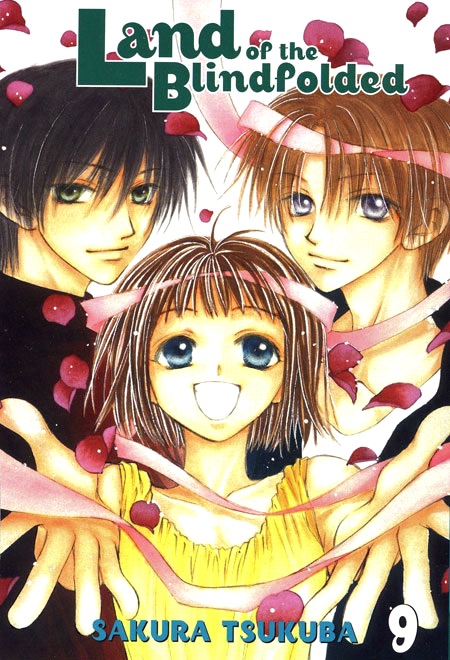 Land of the Blindfolded, or Mekakushi no Kuni, is a nine-volume shoujo manga series by Sakura Tsukuba. It was one of CMX’s debut titles back in 2004, along with some classic titles like Swan and From Eroica with Love. Land of the Blindfolded originally ran in Hakusensha’s LaLa and LaLa DX magazines, and CMX would later go on to pick up another one of her series, Penguin Revolution. Besides these two works, her other series is the Christmas-themed Yoroshiku Master. The rest seems to have been mostly one-shots in different Hakusensha magazines—too bad I missed the two she did in Melody!
Land of the Blindfolded, or Mekakushi no Kuni, is a nine-volume shoujo manga series by Sakura Tsukuba. It was one of CMX’s debut titles back in 2004, along with some classic titles like Swan and From Eroica with Love. Land of the Blindfolded originally ran in Hakusensha’s LaLa and LaLa DX magazines, and CMX would later go on to pick up another one of her series, Penguin Revolution. Besides these two works, her other series is the Christmas-themed Yoroshiku Master. The rest seems to have been mostly one-shots in different Hakusensha magazines—too bad I missed the two she did in Melody!
Kanade Outsuka sees a world full of people wearing “blindfolds.” But every once in a while, for her, that blindfold “slips” and she gets to see what others can’t—in her case, she can see a person’s future. Having a big heart and a determined spirit (as any good Hakusensha heroine should), Kanade will try to intervene if the future she sees will cause someone harm—even if the person she helps thinks that she’s just being weird. Two boys come into her life—Arou, who can see the past and carries around the heavy burden of his own past—and Namiki, who can also see the future but has a very different attitude about it than Kanade does. A sweet romance develops between Kanade and Arou… and I wouldn’t say “hijiinks ensue;” this title is entirely too gentle for much of that.
Michelle, what were your impressions?
MICHELLE: Initially, I was torn. There were certain elements of the story that I liked—the fact that Kanade and Arou become a couple with minimum fuss, Kanade’s spunky best friend (Eri), the neat side abilities that Arou’s power gives him…—but the first few volumes are very episodic and feature chapters with plots like “a plucky abandoned puppy is rescued from his doom during a rainstorm by an angsty boy affected by the protagonist’s shoujo heroine powers.”
The stories begin to take a more interesting turn in volume five, when Arou first uses his power in a new, freaky way to track Kanade after she’s swept away at the beach. And then shortly thereafter, he’s reunited with a classmate from junior high who wants him to use his powers to benefit society by helping to solve murders.
The rest of the volumes are all pretty good, though I’m most fond of volumes six and seven. I note, though, that Kanade really gets the short shrift after a while. She truly is the least interesting character of the bunch, and there is much more time devoted to the traumatic pasts suffered by Arou and Namiki than anything involving Kanade (excepting her decision to come clean to Eri about her ability).
KAREN: It is very episodic, and for me that’s what lead to my assessment of this as being very “gentle”—when stories wrap up each chapter, nothing really seems that dire. Instead, we get a series of ordinary events—the school festival. A clash with student government. The class trip. Hot springs hijinks (okay, so there is a little hijink-ing). The summer festival. And so on.
However, the banality of these events is contrasted with the very unordinary main characters. Here we have a girl who can see the future, but like any other girl her age, she worries about the very ordinary things—will people like the real me? Will I fit in? Can I tell my best friend all of my secrets? It’s this relatability that I think really speaks to the reader. Everyone has insecurities, even these “special” kids.
The “plot” really does pick up later on. I was kinda hoping that Arou’s uncle would be more of a revolutionary character—he seems to have some rather dark intentions—but that fizzled out. I’m not sure if that was a red herring or Tsukuba sending off signals that she didn’t mean to.
I do agree with you, Michelle—Kanade seems to downright disappear in some of the stories, and I wish she had more of a presence. I also like that the coupling happens without a lot of drama—and while the back cover tries to play up the triangle, Kanade and Arou only have eyes for each other. Poor Namiki. At least he got a puppy.
MICHELLE: And possibly the world’s most adorable turtle!
I did find it interesting that although Land of the Blindfolded does include some stock shoujo scenarios—in addition to the ones you named there’s a trip to the amusement park, a trip to the beach, Christmas—they didn’t really annoy me as much as they do in series like, say, Ai Ore! Probably the likeable characters are responsible for that.
And yes, it’s largely the disclosure of the leads’ insecurities that make later volumes more compelling. Learning about Arou’s painful past wherein he was feared and shunned for his abilities makes the present where he is warmly liked and trusted by his classmates that much more significant. Now we can see how much it really means to him. And, too, we learn how scarred Namiki was by his mother’s timidity, and how this contributed to his rather jaded attitude when we first meet him. My absolute favorite scene in the whole series occurs between Namiki and Kanade’s mother, in which she tells him he’s a good boy and he starts to cry. I’m getting a little sniffly just thinking about it, actually.
Yeah, the Sou thing did rather fizzle out, but it all played in to the warm and fuzzy “you are not alone” ending, so maybe that was all Tsukuba intended.
KAREN: That turtle was cute. And the pet-sitter bonus chapter was very cute.
I think it’s because Arou and Namiki had those much heavier pasts that Kanade gets lost. Well, she did see a vision of her grandfather’s death, but she’s from such a kind and accepting family that it becomes something to be overcome rather than something creepy that results in her ostracism. I agree with you, Michelle, about how affecting that one scene with Namiki and Kanade’s mother is—it’s really a moment when this story works. It’s a message that would work for any child that was rejected—that you are good. However, if every chapter/story in Land of the Blindfold was this emotionally wrenching, we wouldn’t be able to get through this review!
Of the secondary characters, I also liked Kaicho-san, the student council president. Her attraction to Arou was handled well, and I’m glad that it didn’t devolve into a Marmalade Boy-style Love Dodecahedron. I did like that it was hinting that Kaicho and Namiki might perhaps hook up, but it that was played well, and I think realistically. They would be good together, but for now they still have their hearts somewhere else. By not rushing them together, Tsukuba didn’t compromise their characters and what they had been about.
The other beta couple, Eri and Ezawa, were presented as the Doomed Couple, but turned into something else, and so much of it was done in the background, as their story would pop in and out, showing their evolution as a couple.
I did want to say one thing about CMX’s presentation—I remember comments at the time about the tightness of the bindings, and wow, the first three volumes were very hard to read. I’m glad that they worked that out for later volumes so I didn’t have to worry about ruining the book when I opened it. The art… works, if that’s a way of putting it. Sakura Tsukuba isn’t one of the great shoujo artists, but her work is expressive and the humorous moments were very cute.
MICHELLE: I liked Kaicho a lot, too (though we eventually learn her last name, we never learn her first one), and was totally bracing for an eventual pairing off with Namiki. I think she could’ve been the heroine of her own manga series, actually.
We don’t learn too much about the inner workings of Eri and Ezawa’s relationship, but I definitely like that he became more interested in her once she showed she wasn’t going to fawn over him mindlessly like everyone else. She basically learns quickly that attempting to change yourself for someone never works, and then they turn out to be a stable couple from then on. Also, Tsukuba makes a few suggestions that they’re doing more than kissing while still keeping the content within an “E for Everyone” rating.
And yes, those fiendish bindings! I actually have the first five in that style and was desperately sick of them and so relieved when volume six came around. I hadn’t realized it, but I guess I hadn’t read any of the really early CMX volumes before this, so I didn’t know how terrible they were.
I don’t seem to have too much to say about Tsukuba’s art, actually. There were a few sequences that I quite liked, but that was more about what was happening in the scene than her skills. She does mention repeatedly how much she loves drawing animals, and adorable critters did seem to be her strong suit.
KAREN: I caught that too with Eri and Ezawa. And how it totally flew over Kanade’s head.
Like most CMX series, Land of the Blindfolded is long out-of-print but easily and inexpensively obtainable on the secondary market. The infamous tight bindings vary—Michelle’s go up to volume five, mine only up to three, but they’re still readable. It’s a good title for the younger YA reader, because there’s nothing objectionable and it is such a sweet story—no questionable misogyny, for example. This is the sort of title that CMX did so well—and something that’s very much missed in the current market. (I’m sure there’s many YA librarians who agree!) Thankfully, though, they did manage to get so many titles out during their time—I’m looking forward to the next title we’re going to cover!
MICHELLE: Which is… drumroll please… Cipher, by Minako Narita! I’ve been meaning to read this for ages, so I’m really excited about next month’s column.
Thanks for joining us this month, and we hope you’ll be back next time!

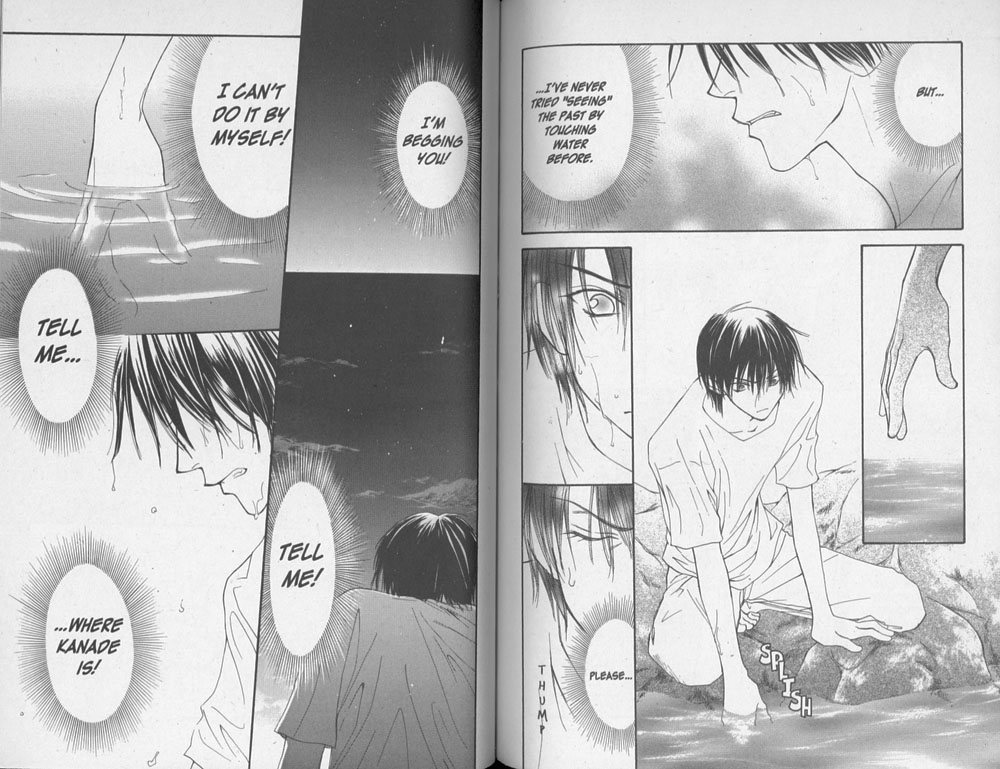
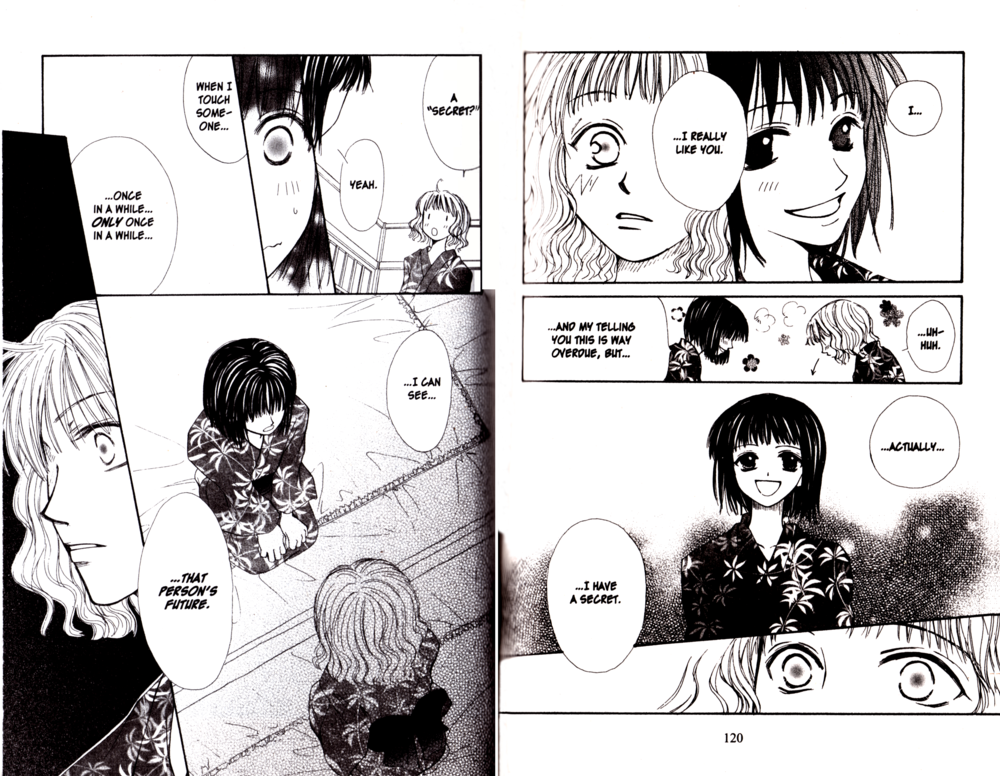

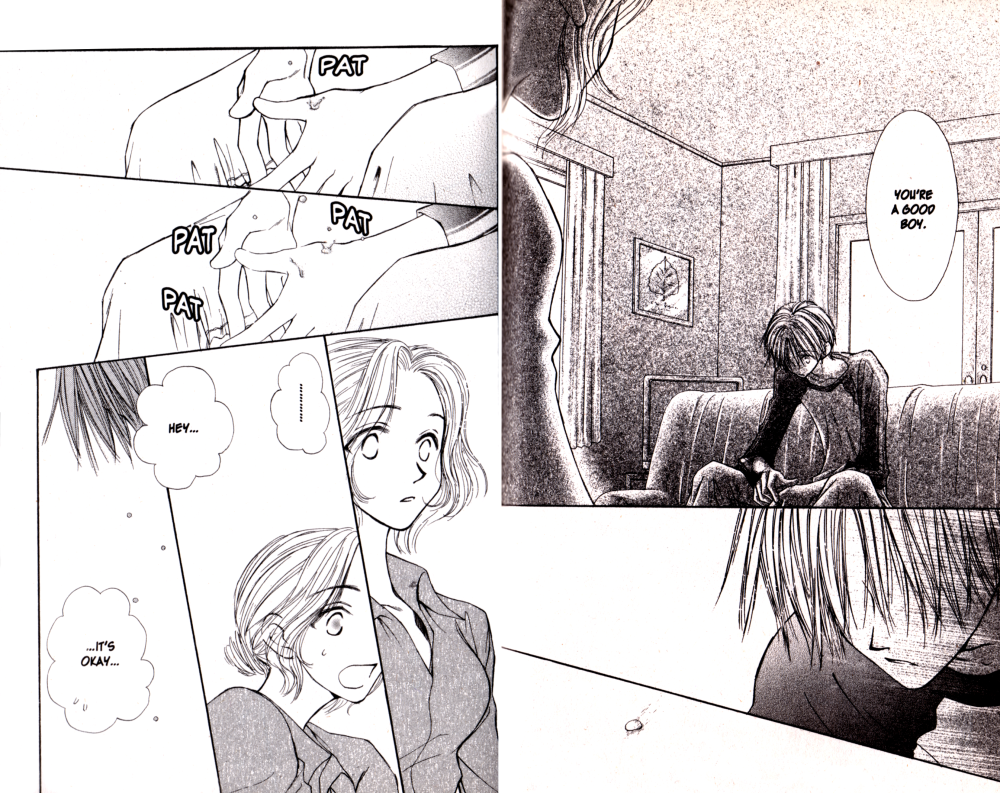
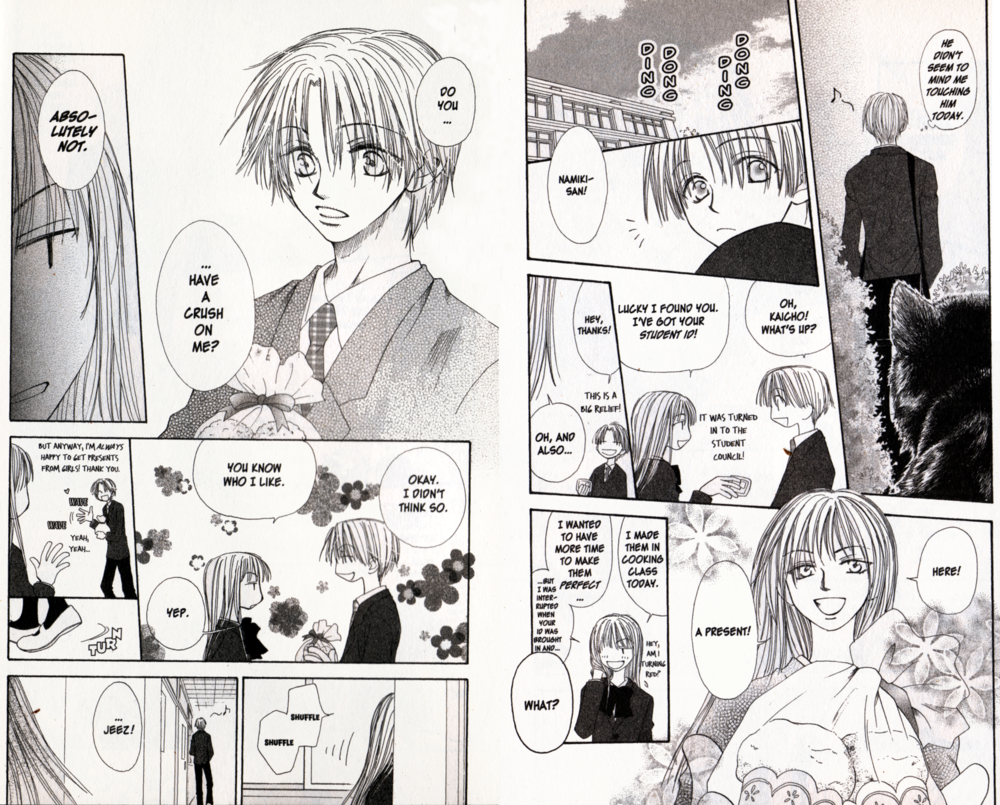
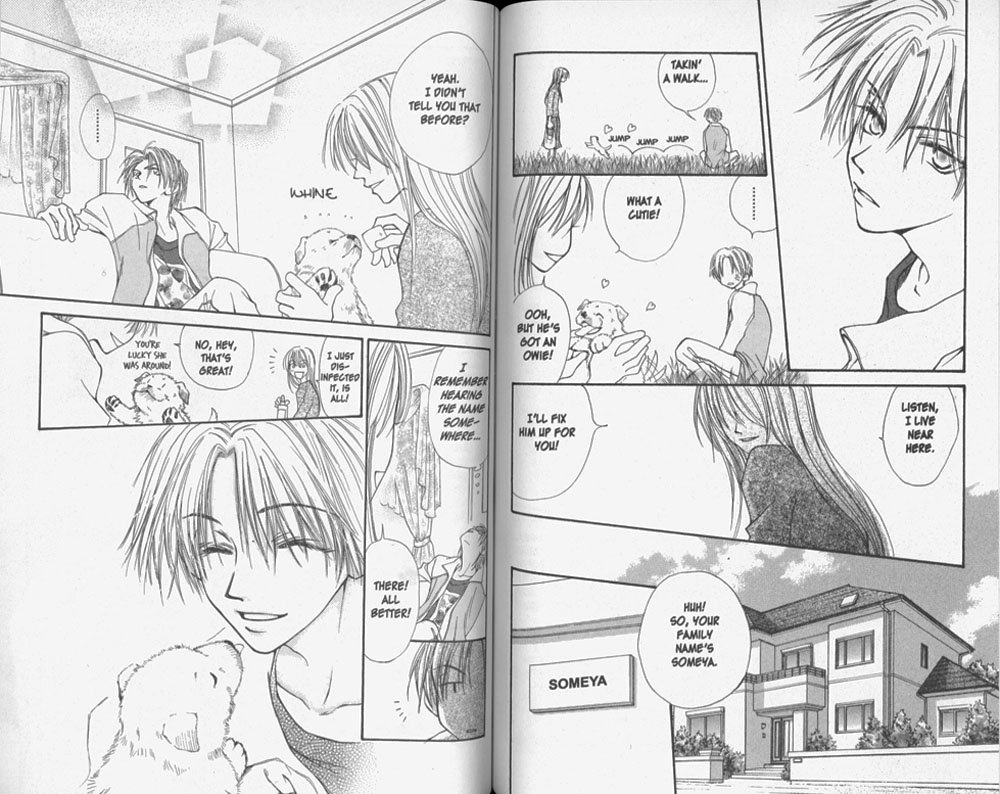



Yay, Cipher is next! You’ll have to tell me which one you found more annoying, the tight bindings on these, or their occasional vertical typing on Cipher in the first two volumes (seriously, what the hell was wrong with them?)
Oh and if you’re up for it, I think it would be hilarious if you watched the Cipher OVA after the manga. It’s a half hour long, it’s on youtube, and dear lord is it terrible. Having read and enjoyed Cipher, the manga made no sense to me, I highly doubt anyone could get anything out of it, but it is enjoyable hilarious.
Ok, Land of the Blindfolded talk time! I got these at the comic shop near my college (back in college) for $5 each. Got the first two on a whim, read some before lab class, and started to get into it more as it went on. I did like how the main focus was the characters and not a messy love dodecahedron that it totally could have gone with. While I think Kanade didn’t much in the character dark past department, I still think she was there as a glue for Namiki and Arou to help them with theirs, and I think that’s ok too. I think it was wise that Tsukuba didn’t bite off more than she could chew. Also, if everyone had a broken home, I think that might’ve been pushing it in the drama department. So I don’t mind laying off it for just Kanade.
Now, being reminded of the main premise every single chapter, that was annoying. I think it’s because it ran every 2 months in Japan, but I just had to start filtering that out. At least actual stuff was going on then too. And I must agree, the shojo tropes of school festival, hot springs, etc, didn’t annoy me very much, I think because I liked the characters and every scenario wasn’t there to make a mess of a love triangle more juicy or something. In addition to cute animals, I also liked how Sakura drew characters smiling or laughing.
I’ve also read Penguin Revolution, I enjoyed it a lot too, but for completely different reasons. After all, PG has cross dressing actors and stuff, and it has more love triangle, but still not as messy as I usually see them. PG definitely had more humor, but I think it was also pretty sweet. Actually, having just read Wild Act, it’s kinda similar to that with all the actor stuff going on. It’s more of a typical shojo fare, but it’s also done really well, so it’s hard for me to complain, I would suggest checking it out if you enjoyed this one.
Hi, and thanks for the reply! I must say you’ve now instilled some worries regarding Cipher, but I guess if nothing else we can talk about its crackaliciousness.
Speaking for myself, I really wasn’t wishing that Kanade had a dark past or a broken home, necessarily. Just that she had something more to do with the story besides being the glue or the one in periodic need of rescue. Like maybe realizing something sinister was going on with Arou’s uncle Sou, for example. She seemed largely oblivious.
I agree about enjoying Tsukuba’s depiction of characters smiling and laughing! That’s part of why I picked that particular image of Namiki’s dog because it also includes a nice panel of Namiki’s reaction to the dog. There are many nice panels of Kanade and Arou smiling together, too. I guess I should’ve found one of those to include but we already had quite a lot of images already! 🙂
Well only the Cipher anime is hilariously bad. I enjoyed the manga quite a bit in a normal shojo manga way (the second half more than the first, I wish the second half had been longer, and it would have been cool if the Alexandrite spin off had come over too), I just don’t know how they got that 30 minute OVA out of that manga. It’s like they went “hey, this takes place in America! And it’s the 80s!” and let every bad idea that could form in their minds make it into the OVA. If the entire premise of your OVA is “80s America is cool”, it’s extra hilariously outdated today, and because it takes place in what Japan thinks is America, there’s that added laugh factor too. Maybe it was fine and actually cool in Japan, but that OVA is just funny to me. I can’t spoil the best reason why though, it will become immediately obvious.
Actually, I was somewhat impressed that some basic research must have been done into American schools for the manga, as there are lockers and there is a lunchroom. It is a shame that no basic research was done for the OVA (and yet there is a 10 minute “making of” feature for the thing showing them in 80s NYC). Oh and in Minako Narita’s 1/4 columns, she often mentioned liking American US 80s music, especially Thompson Twins, yes, there is a TT song in the OVA. But having read and enjoyed the manga, the OVA still makes no sense to me, I can’t imagine how people who don’t even know who the characters are would interpret this OVA.
Oh dear. I now wonder how this depiction of ’80s America will compare to Banana Fish. 🙂
I think the manga are about equally harmless, but the OVA is just hilarious. Since it was made in the 80s, it makes sure to have some nice shots of the Twin Towers, which was fine at the time, but now it only makes the OVA more awkward. But the OVA is more hilarious in that it plays Footloose.
Actually, maybe that’s why Banana Fish shouldn’t have an anime, it might take the 80s thing too far.
Yay for CMX focussed project! I really like to read and reread Mekakushi no Kuni because of the message of acceptance for a person, however odd he/she is. And it’s not too short or long. The mangaka does some lovely oneshots, too – I’ve read those scanlated only, though.
Cypher is an experience and so 80s it should be a cult classic. I liked reading Alexandrite as well, but that is also only available in scanlation. At least I was fast enough to get the whole Cypher release when it came out. If I hadn’t heard about it in scanlation circles I would never have bought it blindly, though.
Karen and I both have pretty substantial CMX collections, luckily. I’m sure she’s read a lot more of hers, though. Back when these were coming out, it was common for me to buy an entire series and then just hold onto it a while. Now I’m less likly to do that, but it worked out then ‘cos I didn’t have to scramble later for hard-to-find volumes.
I bought a lot of my CMX collection around the closedown, so I have a lot to read that will be New To Me when we read it for future installments. Knowing how the secondary market can get, I thought it was a good buy in order to have years of future reading. 🙂
I did that for some things. Like, I distinctly remember being half a dozen volumes behind on acquiring Pieces of a Spiral and I Hate You More Than Anyone and then scrambling to collect them before they disappeared. But for others, I purchased them as they came out.
I don’t think I knew about a single CMX title until about 5 months before they went out of business. I think all the CMX titles I’ve acquired were done so after the fact, sadly. If Borders had carried these titles, I probably would’ve given them a lot more money a lot sooner, but I wasn’t buying much on the internet at that time. I’ve still managed to get a good number though, 8 or 9 complete series. I blame DC entirely for not promoting CMX more and for stopping the publication of manga when they had such awesome titles! I’ve been boycotting them ever since.
I saw the occasional CMX title at my local Borders and Books-A-Million, but certainly not many. And since I never bought anything from DC *before* CMX, and haven’t been tempted by anything since, I can’t really stage an effective boycott. 🙂
Yeah, my boycott sucks too. But now I am trying to branch out into US comics, and I’m refusing all things DC. Also, DC does put out Batman movies and stuff, and I’m not going to see a single one from here on out. Seeing how they tend to do well at box office, my refusal to go isn’t doing much, but I still refuse.
I TOTALLY agree with your reading of DC’s mishandling here. I stopped buying their comics when I got into manga in the first place.
I do that occasionally, too. I read all of Basara in scanlation but haven’t read the full series standing on my shelves yet. And with regards to CMX series – well I have all of Tower of the Future, but I haven’t read it past the first volume yet.
Uh-oh, it sounds like the entire purpose of this column is to let me discover series I want to buy, crap (as if House of 1000 Manga wasn’t bad enough on it’s own!). Kidding aside, I found the first volume of this at my school’s library a few years ago and I thought it was a fairly cute story, basically the way you guys summed it up, guess I should keep an eye out for other volumes as well.
Maybe we need a disclaimed. “Warning: The CMX Project may be harmful to your wallet.” 🙂
But yes, if you liked the first volume, you’ll probably like it even more after around volume five or so.
Lol, this and House of 100 Manga need that warning for sure. Regardless, can’t wait for the next post!
Thanks! It’ll probably be in the end of February sometime.
And ironically enough house of 1000 manga is also covering Cipher. xD
This is such a fantastic idea for a recurring feature! I’m a big fan of classic/off-beat manga and CMX seems to have published quite a few of those. Unfortunately, I was on kind of a manga hiatus when CMX was in business and now so much of their stuff is hard to get a hold of, incomplete, or both. It’s nice to have some trustworthy, informed folks sifting through all of this rich material.
Thank you for the compliments! It’s kind of surprising when one lists out everything CMX did manage to release during their years of operation, My hope is that we will eventually cover all, or at least nearly all of it, but there are some things that neither of us have. We probably do have enough to run monthly columns for a couple of years, though, at least. 🙂
I’m so happy to see that this will be a regular column! CMX had so many wonderful, overlooked series to its name.
I personally enjoyed Land of the Blindfolded, though not as much as Tsukuba’s other series, Penguin Revolution. I never doubted that Arou and Kanade were going to stay together and be perfectly, adorably in love until the very end, which was actually quite heartening when so many shoujo manga rely on complicated relationships for their plot. Tsukuba’s characters are refreshingly honest and self-aware, so angst and drama fizzles out just as soon as it’s introduced. (With the exception of Arou and Namiki’s entertaining back stories.)
I think the scene you used for Kaicho and Namiki is a good example: she does something that could be considered romantic, he asks her immediately if that’s what it is, and when she says no, they both just go on with their days.
“Gentle” is the perfect word for it. Rather similar to how I felt reading Eensy Weensy Monster, or certain chapters of Kimi ni Todoke.
Thanks for the comment! I agree with you on all points! Arou and Kanade’s relationship was stable and cute without being stagnant, the Kaicho/Namiki interactions are always interesting (there’s a little more overt hinting in the final volume, but I wanted to include this one because of her reaction), and there is a similar feel between this and Eensy Weensy Monster, which I also enjoyed. I’d stop short of comparing this to Kimi ni Todoke, just ‘cos the latter is better at developing its female cast and yet not overshadowing its heroine.
I read the first three and volume five through my locla Library and personaly I think it was better as a one shot in short I just felt it was a “meh” title
How timely! I actually bought a complete set of this series a couple of weeks ago at Half-Price Books. Five of the volumes had those super annoying tight bindings, but other than that, I was quite pleased with the purchase. It’s not an amazing series by any means, but it was a (mostly) light and fluffy read. I also liked that Kanade and Arou’s romance was low-key and sweet instead of drama-filled. I have to say that my favorite character, though, was the dog. I’m not even a dog person, but he was so freakin’ adorable that I couldn’t help but smile every time he was on the page. Loved the little bonus chapters that focused on him, too!
I’m not a dog person, either, but also found him adorable. I almost scanned one of the stories where he has some narration, but ultimately I thought the panel of him bouncing over to greet Kaicho was too cute to miss. 🙂
I was always a little afraid of investing in Land of the Blindfolded because I tend to not get very attached to episodic series, but this has piqued my interest. And if I remember correctly, Land of the Blindfolded was one of the few shojo series CMX managed to fully release before shutting down.
Thanks for the comment! 🙂 CMX actually finished quite a few shojo series. Off the top of my head, besides Land of the Blindfolded, there’s Cipher, Moon Child, King of Cards, Oyayubihime Infinity, Tears of a Lamb, Palette of 12 Secret Colors, Recipe for Gertrude, Name of the Flower, Pieces of a Spiral, Seimaden, Canon, The Devil Does Exist, Empty Empire, Key to the Kingdom, Vs., Gals!, Kamikaze Kaito Jeanne, Omukae Desu., Penguin Revolution, and Tower of the Future. Plus a handful of really short series. And, of course, Emma, which isn’t shoujo, but whose completion should be celebrated. 🙂
Thanks for that list! I guess it just seemed like CMX didn’t finish the series I most wanted to read (namely I Hate You More than Anyone and Swan). I read The Devil Does Exist, but it had a lot of useless drama so I ended up not caring for the series. I love the Gals! anime, but never got around to the manga. And this list reminded me that Name of the Flower sounds interesting – and since it was completed I’d like to give it a try.
By the way, I think this project is a great idea – I can’t wait to see what you guys write about after Cipher!
Thanks! We were supposed to have the Cipher post up in February, but life intervened, so we’re hoping for next weekend.